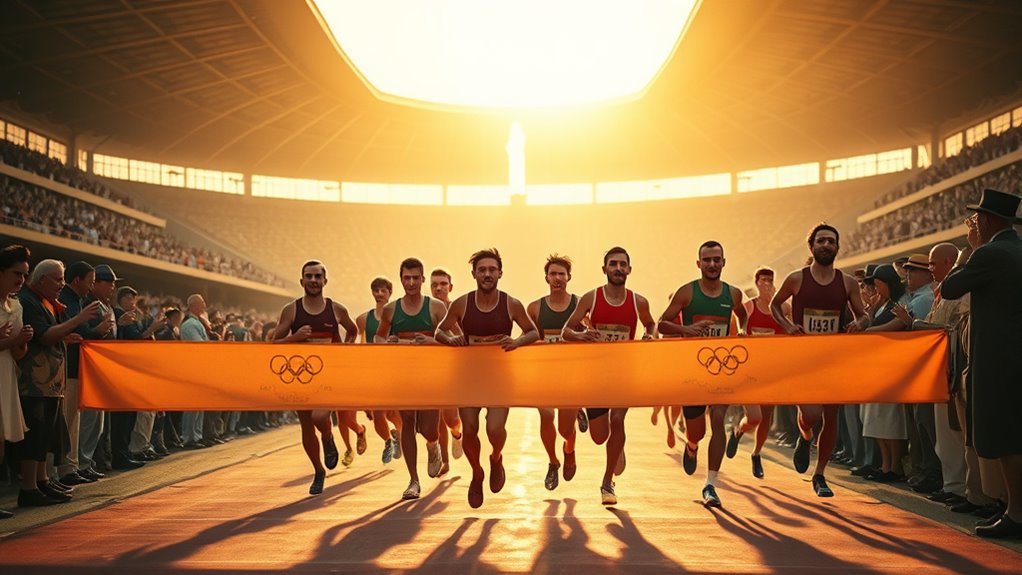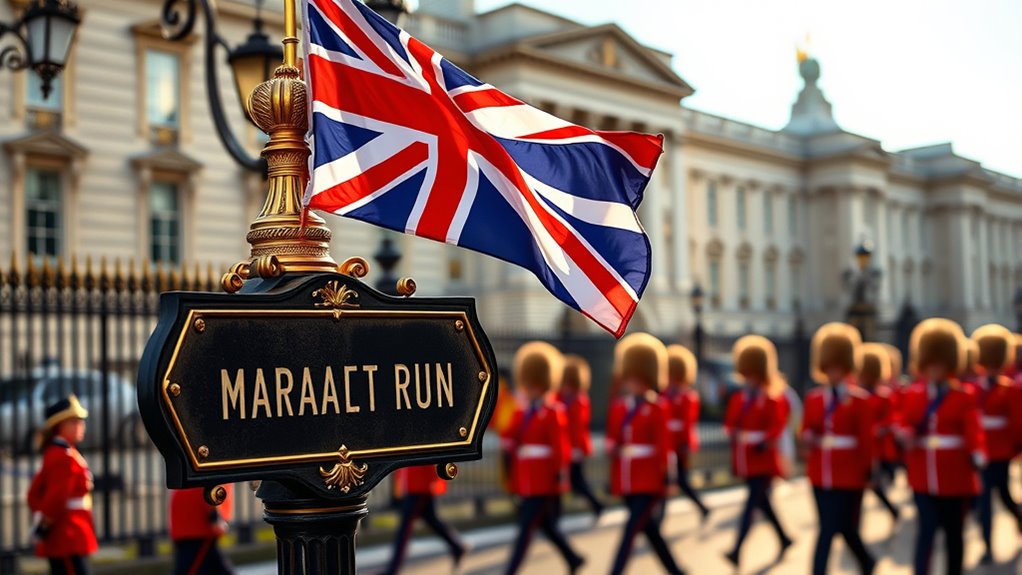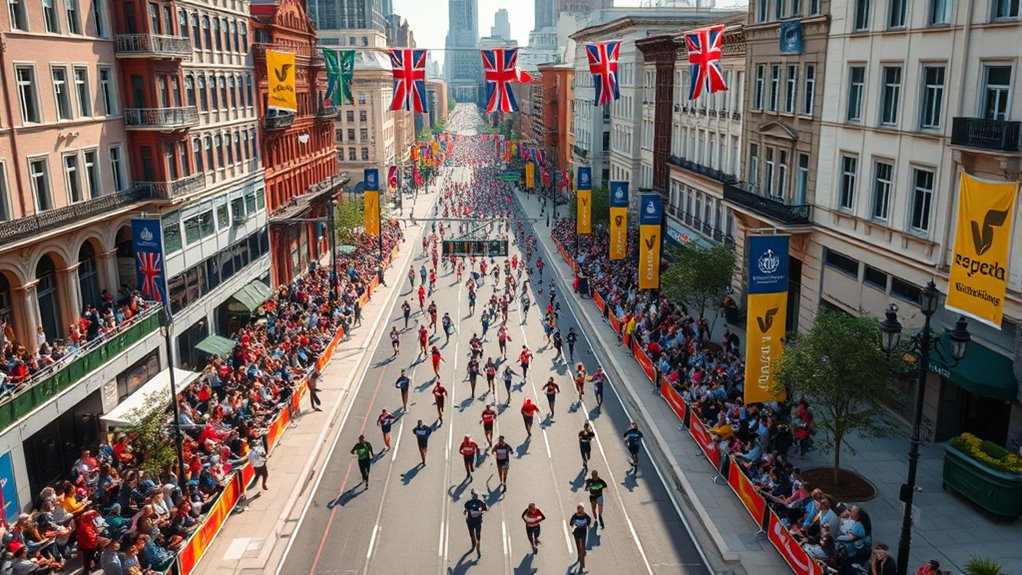The reason it’s 26.2 miles comes from a mix of history, legend, and royal influence. The story of Pheidippides’ legendary run from Marathon to Athens inspired the idea of endurance. The first modern race in 1896 honored that legacy, but it wasn’t until the 1908 Olympics that the distance was officially set at about 26 miles to accommodate royal viewing preferences. In 1921, it was standardized at 26.2 miles. Curious about the full story? Keep exploring to discover more.
Key Takeaways
- The marathon’s 26.2-mile distance was standardized after the 1908 London Olympics to include royal viewing preferences.
- The original run by Pheidippides inspired the legend but did not specify a fixed race distance.
- The 1908 route was extended to start at Windsor Castle and end at the royal box, influencing the modern length.
- The official distance of 26.2 miles was set in 1921 to ensure consistency across future races.
- The distance symbolizes endurance and heroism, rooted in Greece’s historic battle and mythic legacy.
The Origin of the Marathon Race

The origin of the marathon race traces back to ancient Greece, where a legendary messenger named Pheidippides ran approximately 26 miles from the battlefield of Marathon to Athens to deliver news of a Greek victory. This story is rooted in ancient legends that emphasize endurance and heroism. Over the centuries, the marathon transformed from a mythic tale into a modern sporting event. Today, the distance of 26.2 miles is set by modern standards, reflecting a specific historical race rather than the original run. Interestingly, the soil conditions during that historic race are believed to have influenced the runner’s stamina and pace, highlighting the importance of environmental factors even in legendary tales. Additionally, race logistics such as course layout and weather conditions played a role in shaping the modern marathon experience. While the true details of Pheidippides’s journey may blend legend with history, the marathon’s roots highlight a story of perseverance that continues to inspire runners worldwide. This blend of ancient legend and modern standards defines the essence of the race, and the dog quotes for reflection and humor can serve as a lighthearted reminder of perseverance in everyday life.
The Legendary Run of Pheidippides

You’ve probably heard about Pheidippides’ famous run, but understanding its context makes it even more remarkable. His swift message carried news of the Greek victory at the Battle of Marathon, inspiring future generations. This legendary feat cemented his legacy and shaped the marathon race we celebrate today. Interestingly, the modern marathon distance of 26.2 miles was standardized based on historical exotic fruit blend inspirations for refreshing drinks and other factors, creating a practical and memorable race length. Additionally, the practice of dedicating time to sound design can deepen our appreciation for such historic events and their storytelling. Recognizing cryptocurrency market trends helps us understand the broader context of how such iconic distances and stories have evolved over time.
Greek Messenger’s Historic Run
In 490 BC, Pheidippides, a Greek messenger, ran approximately 26 miles from the battlefield of Marathon to Athens to deliver urgent news of the Persian defeat. His legendary run sparked many marathon myths, but it also highlights the race logistics of ancient Greece. You can imagine him:
- Sprinting through rugged terrain, dodging rocks and trees
- Breathing heavily as the weight of his message bears down
- Pushing through fatigue, driven by patriotic duty
- Collapsing upon reaching Athens, exhausted but victorious
This historic run underscores how the story’s details have shaped the modern marathon. While the original race was a one-time event, it inspired the idea of a long-distance race rooted in history, blending myth and reality. Your understanding of marathon myths begins here. The legendary run captures the enduring spirit of perseverance that defines the race today.
The Battle of Marathon
Did you ever wonder what sparked the legendary run of Pheidippides? It all began during the Battle of Marathon, a pivotal clash between the Greeks and the Persians. The Greeks faced overwhelming odds, but their victory became a symbol of courage and resilience. According to marathon myths, Pheidippides ran tirelessly from the battlefield to Athens to deliver news of the triumph. This race symbolism has endured, representing determination and patriotism. The story captures the spirit of pushing limits, which is why the marathon distance was linked to that historic run. While some details may be exaggerated, the legend emphasizes human endurance and the power of perseverance, inspiring countless runners and shaping the race’s enduring significance today. Additionally, the connection to road signs and their role in guiding athletes and spectators alike underscores the importance of clear communication and safety in such events.
Legacy of Pheidippides
The legendary run of Pheidippides has left a lasting legacy that transcends ancient history and inspires modern endurance. His heroic effort symbolizes determination, sacrifice, and the power of perseverance. Today, ancient legends like Pheidippides fuel modern traditions such as marathons worldwide. You can imagine the scene:
- A single messenger sprinting across rugged terrain
- His unwavering focus amid chaos
- The moment he delivers news of victory
- The enduring inspiration for thousands running today
This story reminds us that great feats are rooted in history but live on through contemporary celebrations. Pheidippides’s legendary run continues to motivate runners, emphasizing resilience and the spirit of endurance that define both ancient legends and modern marathons.
The First Modern Marathon in 1896

In 1896, the Athens Marathon marked the first modern race inspired by ancient legends. You’ll learn how the event revived the Athens Marathon origins and celebrated the heroic run of Pheidippides. This race set the stage for the marathon’s inclusion in the Olympic Games and shaped its iconic distance.
Athens Marathon Origins
Although the modern marathon race traces its roots to a specific historical event, its origins are closely linked to the revival of the ancient Greek story of endurance and victory. During the 1896 Athens Olympics, organizers aimed to honor Greek traditions and connect the event to ancient legends. The race followed a route from Marathon to Athens, symbolizing the legendary run of Pheidippides. This event marked a pivotal moment in modern interpretations of ancient traditions, blending history with athletic innovation. You can imagine the scene:
- Runners charging through historic plains
- Crowds cheering in the birthplace of democracy
- The spirit of ancient warriors fueling competitors
- Celebrating Greek resilience and heritage
This race set the foundation for today’s marathons, merging mythic endurance with contemporary sport.
Heroic Pheidippides Run
Have you ever wondered how the first modern marathon came to be? In 1896, during the Athens Olympics, a Greek soldier named Pheidippides ran about 26 miles from Marathon to Athens to deliver urgent news of victory. His heroic run inspired organizers to include a race mimicking his feat, sparking the marathon tradition. If you’re training for a marathon, understanding Pheidippides’ legendary effort can motivate your marathon training. Back then, runners relied on minimal running gear, just like Pheidippides’ simple clothing. Today, modern runners use advanced running gear to enhance performance and comfort. That first heroic run set the stage for a race that now symbolizes endurance, determination, and history—connecting you to a legendary act of human perseverance.
Revival at Athens Games
The 1896 Athens Olympics marked a pivotal moment when the marathon made its debut as a modern sporting event. Inspired by ancient myths, organizers aimed to revive the legendary run of Pheidippides, blending history with modern traditions. You can imagine the scene:
- Athletes lining up amidst historic ruins, enthusiastic to honor Greece’s past
- Crowds cheering loudly, blending excitement with reverence for ancient stories
- The sun beating down on a route that traced the original route from Marathon to Athens
- A finish line that symbolized both athletic achievement and cultural heritage
This race sparked a global fascination, merging ancient myths with modern traditions, and laid the foundation for the marathon’s enduring legacy. It’s a story of how history and sport beautifully intertwine.
Standardizing the Distance: The 1908 London Olympics

Ever wonder how the marathon distance became standardized? The historical evolution of marathon measurements was mostly informal until the 1908 London Olympics. Prior to that, races varied greatly in length, making comparisons difficult. During these Games, organizers needed a specific measurement standard to guarantee fairness, especially for the marathon that started at Windsor Castle and finished in front of the royal box at White City Stadium. They set the distance at approximately 26 miles, with the final stretch to the royal box added for visibility. This marked a turning point, establishing a measurement standard that others would follow. The 1908 marathon’s distance became the prototype, shaping the modern marathon and cementing 26.2 miles as the official length.
The Role of the British Royal Family

The British royal family played a pivotal role in shaping the marathon’s history, beginning with the 1908 London Olympics. Their royal sponsorship added prestige, elevating the event’s profile worldwide. You can imagine the pageantry, with ceremonial traditions like royal observers and medals presented by royalty, reinforcing the race’s importance. They helped popularize marathons through their support and attendance, creating a sense of grandeur. Picture these moments:
- A royal figure watching from the sidelines
- Medals awarded amidst ceremonial applause
- Public enthusiasm driven by royal endorsement
- The royal family’s involvement inspiring future marathons
Their influence cemented the marathon as a prestigious event, blending athletic achievement with royal tradition, and ensuring the race’s legacy endures. This royal touch transformed a race into a national celebration rooted in history.
Why the Distance Changed in 1921

In 1921, organizers officially standardized the marathon distance to 26.2 miles, a change driven by a desire for consistency and precision in the race’s measurements. The marathon’s origins trace back to ancient Greece, but it wasn’t until the early 20th century that distance standardization became essential. The 1908 London Olympics set a confusing precedent with varying race lengths, prompting officials to establish a fixed distance. The 26.2-mile mark was finalized after the 1908 marathon, when the course was extended to fit the royal family’s viewing preferences. This adjustment guaranteed uniformity across future races, making the marathon a consistent challenge worldwide. Standardizing the distance helped solidify the marathon’s identity and allowed runners to prepare with confidence.
The Impact of the 26.2 Miles Mark Today

Today, the 26.2-mile distance shapes how you train, strategize, and experience the marathon. It influences marathon marketing, emphasizing the challenge and achievement of completing this iconic distance. You focus on athletic training to build endurance, speed, and mental toughness for the full course. This distance also sparks community spirit, inspiring runners worldwide to push their limits.
- Runners set personal goals based on this historic mark
- Training plans revolve around building stamina for 26.2 miles
- Race strategies optimize pacing over the full distance
- Events celebrate milestones, making the marathon a global phenomenon
The 26.2-mile distance remains a symbol of perseverance, shaping every aspect of modern marathon culture and athletic preparation.
Surprising Facts and Myths About the Distance

Many people assume they know everything about the 26.2-mile marathon distance, but some surprising facts and myths still circulate. You might have heard marathon myths like the idea that the distance was chosen to be exactly 26.2 miles from a specific historical event, but that’s not entirely true. Some believe the length was based on the length of the original Olympic course, but the story is more complex. Distance myths can also include the belief that all marathons are exactly 26.2 miles; in reality, course variations exist. These misconceptions persist, but understanding the true origins helps you appreciate how the marathon’s distance was standardized and why it remains a symbol of endurance and determination.
Frequently Asked Questions
Why Was the Marathon Distance Originally Chosen at Approximately 26 Miles?
You might wonder why the marathon was set at roughly 26 miles. Historically, the distance traces back to ancient origins, where early races varied in length. Modern standards were established during the 1908 London Olympics, when the course was extended to fit around the royal family’s viewing box, resulting in the 26.2 miles standard. This blend of tradition and practical adjustments defines the marathon’s current, standardized length.
How Did the Specific 26.2 Miles Become the Official Marathon Distance?
You might wonder how the 26.2 miles became official. It traces back to ancient origins and mythological stories, but the modern standard started in 1908. The British royal family requested the race start at Windsor Castle and finish in front of the royal box at White City Stadium, totaling 26.2 miles. This distance was later adopted by the Olympics and became the standard marathon length, blending history with tradition.
Are There Any Other Official Marathon Distances Around the World?
Did you know there are alternative race formats and variations in international marathon standards? While most official marathons stick to the 26.2 miles distance, some events, like ultramarathons, extend well beyond that. Additionally, certain countries or races might have slightly different standards for official marathon times or course measurements, but the 26.2-mile mark remains the global benchmark for marathon races worldwide.
How Has Technology Influenced Marathon Training and Race Distances?
Technology has transformed how you train for marathons. Wearable technology like GPS watches tracks your pace, distance, and heart rate, helping you optimize your runs. Virtual training platforms enable you to connect with coaches and runners worldwide, offering personalized plans and motivation. These innovations make it easier to prepare and adapt, ensuring you reach your goals more efficiently and safely, regardless of race distances or locations.
What Are Some Common Misconceptions About the History of the Marathon Distance?
Many people believe that the marathon distance was set in stone during the first modern Olympics, but that’s a historical myth. You might think the distance was based on a precise measurement, yet it actually evolved over time through historical myths and race routes. Some also assume it was always 26.2 miles, but it varied before becoming standardized. Don’t fall for distance myths—understanding the true history reveals a fascinating story behind this iconic race.
Conclusion
Now you know why the marathon is 26.2 miles—rooted in history, tradition, and a bit of royal influence. Did you know that over 800,000 people finish marathons in the U.S. alone each year? That shows just how much this race has captured our imaginations. So, next time you lace up, remember you’re part of a centuries-old story that continues to inspire millions worldwide.









